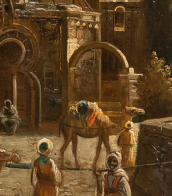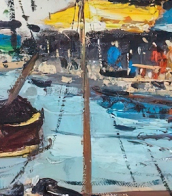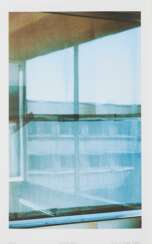eberhard

Eberhard Viegener was a German expressionist painter, decorator, and printmaker.
In the 1930s his expressionist works were deemed "degenerate," and during the Nazi "Degenerate Art" campaign a considerable number of them were removed from state collections and destroyed.
Later Figener shifted abruptly from the expressionist style to the style of New Objectivity, or Neue Sachlichkeit. He began to paint, in particular, architectural still lifes with ceramic objects.
Eberhard Figener was the brother of the painter and sculptor Fritz Figener.




Eberhard Havekost is a German painter.
Havekost studied at the Dresden Academy of Art. Working from his own collection of photographs and videos, he reworked the original images on the computer: slightly changing the shades, subtly stretching and distorting the shapes. These transformations were then embodied in the drawing process, and the result is not photographic precision, but rather fleeting moments of abstract perception. Havekost often depicted modernist urban buildings as a means of referencing 20th century post-war politics and failed utopian visions. Hafecost also painted portraits and domestic paintings.
In 2010, Havekost was appointed professor of painting at the Academy of Fine Arts Düsseldorf. His work has been exhibited at major German and international institutions and is represented in numerous institutional and private collections.


Eberhard Havekost is a German painter.
Havekost studied at the Dresden Academy of Art. Working from his own collection of photographs and videos, he reworked the original images on the computer: slightly changing the shades, subtly stretching and distorting the shapes. These transformations were then embodied in the drawing process, and the result is not photographic precision, but rather fleeting moments of abstract perception. Havekost often depicted modernist urban buildings as a means of referencing 20th century post-war politics and failed utopian visions. Hafecost also painted portraits and domestic paintings.
In 2010, Havekost was appointed professor of painting at the Academy of Fine Arts Düsseldorf. His work has been exhibited at major German and international institutions and is represented in numerous institutional and private collections.


Eberhard Viegener was a German expressionist painter, decorator, and printmaker.
In the 1930s his expressionist works were deemed "degenerate," and during the Nazi "Degenerate Art" campaign a considerable number of them were removed from state collections and destroyed.
Later Figener shifted abruptly from the expressionist style to the style of New Objectivity, or Neue Sachlichkeit. He began to paint, in particular, architectural still lifes with ceramic objects.
Eberhard Figener was the brother of the painter and sculptor Fritz Figener.


Eberhard Viegener was a German expressionist painter, decorator, and printmaker.
In the 1930s his expressionist works were deemed "degenerate," and during the Nazi "Degenerate Art" campaign a considerable number of them were removed from state collections and destroyed.
Later Figener shifted abruptly from the expressionist style to the style of New Objectivity, or Neue Sachlichkeit. He began to paint, in particular, architectural still lifes with ceramic objects.
Eberhard Figener was the brother of the painter and sculptor Fritz Figener.


Eberhard Viegener was a German expressionist painter, decorator, and printmaker.
In the 1930s his expressionist works were deemed "degenerate," and during the Nazi "Degenerate Art" campaign a considerable number of them were removed from state collections and destroyed.
Later Figener shifted abruptly from the expressionist style to the style of New Objectivity, or Neue Sachlichkeit. He began to paint, in particular, architectural still lifes with ceramic objects.
Eberhard Figener was the brother of the painter and sculptor Fritz Figener.


Eberhard Viegener was a German expressionist painter, decorator, and printmaker.
In the 1930s his expressionist works were deemed "degenerate," and during the Nazi "Degenerate Art" campaign a considerable number of them were removed from state collections and destroyed.
Later Figener shifted abruptly from the expressionist style to the style of New Objectivity, or Neue Sachlichkeit. He began to paint, in particular, architectural still lifes with ceramic objects.
Eberhard Figener was the brother of the painter and sculptor Fritz Figener.


Eberhard Viegener was a German expressionist painter, decorator, and printmaker.
In the 1930s his expressionist works were deemed "degenerate," and during the Nazi "Degenerate Art" campaign a considerable number of them were removed from state collections and destroyed.
Later Figener shifted abruptly from the expressionist style to the style of New Objectivity, or Neue Sachlichkeit. He began to paint, in particular, architectural still lifes with ceramic objects.
Eberhard Figener was the brother of the painter and sculptor Fritz Figener.


Eberhard Havekost is a German painter.
Havekost studied at the Dresden Academy of Art. Working from his own collection of photographs and videos, he reworked the original images on the computer: slightly changing the shades, subtly stretching and distorting the shapes. These transformations were then embodied in the drawing process, and the result is not photographic precision, but rather fleeting moments of abstract perception. Havekost often depicted modernist urban buildings as a means of referencing 20th century post-war politics and failed utopian visions. Hafecost also painted portraits and domestic paintings.
In 2010, Havekost was appointed professor of painting at the Academy of Fine Arts Düsseldorf. His work has been exhibited at major German and international institutions and is represented in numerous institutional and private collections.


Heinrich Eberhard was a German modernist painter.
Eberhard studied at the Royal Academy of Fine Arts in Stuttgart, and was decisively influenced in his artistic development by the modernist pioneer Adolf Helzel (1853-1934). In 1920 he became a member of the Stuttgart "Üecht Group", which also included Willy Baumeister and Oskar Schlemmer, and was a member of the legendary Hölzelkreis.
Eberhard's oeuvre includes oil paintings, drawings, prints and stained glass windows and is characterized by a stylistic pluralism between expressive naturalism, cubist influences and abstraction.
During the Nazi "Degenerate Art" campaign in Germany in 1937, some of the artist's paintings were removed from galleries and destroyed, but in 1943 he was allowed to exhibit one canvas that met the tastes of the authorities. After the war, Eberhard continued to create with success, participating in exhibitions.


Heinrich Eberhard was a German modernist painter.
Eberhard studied at the Royal Academy of Fine Arts in Stuttgart, and was decisively influenced in his artistic development by the modernist pioneer Adolf Helzel (1853-1934). In 1920 he became a member of the Stuttgart "Üecht Group", which also included Willy Baumeister and Oskar Schlemmer, and was a member of the legendary Hölzelkreis.
Eberhard's oeuvre includes oil paintings, drawings, prints and stained glass windows and is characterized by a stylistic pluralism between expressive naturalism, cubist influences and abstraction.
During the Nazi "Degenerate Art" campaign in Germany in 1937, some of the artist's paintings were removed from galleries and destroyed, but in 1943 he was allowed to exhibit one canvas that met the tastes of the authorities. After the war, Eberhard continued to create with success, participating in exhibitions.


Heinrich Eberhard was a German modernist painter.
Eberhard studied at the Royal Academy of Fine Arts in Stuttgart, and was decisively influenced in his artistic development by the modernist pioneer Adolf Helzel (1853-1934). In 1920 he became a member of the Stuttgart "Üecht Group", which also included Willy Baumeister and Oskar Schlemmer, and was a member of the legendary Hölzelkreis.
Eberhard's oeuvre includes oil paintings, drawings, prints and stained glass windows and is characterized by a stylistic pluralism between expressive naturalism, cubist influences and abstraction.
During the Nazi "Degenerate Art" campaign in Germany in 1937, some of the artist's paintings were removed from galleries and destroyed, but in 1943 he was allowed to exhibit one canvas that met the tastes of the authorities. After the war, Eberhard continued to create with success, participating in exhibitions.


Eberhard Viegener was a German expressionist painter, decorator, and printmaker.
In the 1930s his expressionist works were deemed "degenerate," and during the Nazi "Degenerate Art" campaign a considerable number of them were removed from state collections and destroyed.
Later Figener shifted abruptly from the expressionist style to the style of New Objectivity, or Neue Sachlichkeit. He began to paint, in particular, architectural still lifes with ceramic objects.
Eberhard Figener was the brother of the painter and sculptor Fritz Figener.


Eberhard Viegener was a German expressionist painter, decorator, and printmaker.
In the 1930s his expressionist works were deemed "degenerate," and during the Nazi "Degenerate Art" campaign a considerable number of them were removed from state collections and destroyed.
Later Figener shifted abruptly from the expressionist style to the style of New Objectivity, or Neue Sachlichkeit. He began to paint, in particular, architectural still lifes with ceramic objects.
Eberhard Figener was the brother of the painter and sculptor Fritz Figener.


Eberhard Viegener was a German expressionist painter, decorator, and printmaker.
In the 1930s his expressionist works were deemed "degenerate," and during the Nazi "Degenerate Art" campaign a considerable number of them were removed from state collections and destroyed.
Later Figener shifted abruptly from the expressionist style to the style of New Objectivity, or Neue Sachlichkeit. He began to paint, in particular, architectural still lifes with ceramic objects.
Eberhard Figener was the brother of the painter and sculptor Fritz Figener.


Eberhard Viegener was a German expressionist painter, decorator, and printmaker.
In the 1930s his expressionist works were deemed "degenerate," and during the Nazi "Degenerate Art" campaign a considerable number of them were removed from state collections and destroyed.
Later Figener shifted abruptly from the expressionist style to the style of New Objectivity, or Neue Sachlichkeit. He began to paint, in particular, architectural still lifes with ceramic objects.
Eberhard Figener was the brother of the painter and sculptor Fritz Figener.


Eberhard Viegener was a German expressionist painter, decorator, and printmaker.
In the 1930s his expressionist works were deemed "degenerate," and during the Nazi "Degenerate Art" campaign a considerable number of them were removed from state collections and destroyed.
Later Figener shifted abruptly from the expressionist style to the style of New Objectivity, or Neue Sachlichkeit. He began to paint, in particular, architectural still lifes with ceramic objects.
Eberhard Figener was the brother of the painter and sculptor Fritz Figener.


Heinrich Eberhard was a German modernist painter.
Eberhard studied at the Royal Academy of Fine Arts in Stuttgart, and was decisively influenced in his artistic development by the modernist pioneer Adolf Helzel (1853-1934). In 1920 he became a member of the Stuttgart "Üecht Group", which also included Willy Baumeister and Oskar Schlemmer, and was a member of the legendary Hölzelkreis.
Eberhard's oeuvre includes oil paintings, drawings, prints and stained glass windows and is characterized by a stylistic pluralism between expressive naturalism, cubist influences and abstraction.
During the Nazi "Degenerate Art" campaign in Germany in 1937, some of the artist's paintings were removed from galleries and destroyed, but in 1943 he was allowed to exhibit one canvas that met the tastes of the authorities. After the war, Eberhard continued to create with success, participating in exhibitions.


Heinrich Eberhard was a German modernist painter.
Eberhard studied at the Royal Academy of Fine Arts in Stuttgart, and was decisively influenced in his artistic development by the modernist pioneer Adolf Helzel (1853-1934). In 1920 he became a member of the Stuttgart "Üecht Group", which also included Willy Baumeister and Oskar Schlemmer, and was a member of the legendary Hölzelkreis.
Eberhard's oeuvre includes oil paintings, drawings, prints and stained glass windows and is characterized by a stylistic pluralism between expressive naturalism, cubist influences and abstraction.
During the Nazi "Degenerate Art" campaign in Germany in 1937, some of the artist's paintings were removed from galleries and destroyed, but in 1943 he was allowed to exhibit one canvas that met the tastes of the authorities. After the war, Eberhard continued to create with success, participating in exhibitions.


Heinrich Eberhard was a German modernist painter.
Eberhard studied at the Royal Academy of Fine Arts in Stuttgart, and was decisively influenced in his artistic development by the modernist pioneer Adolf Helzel (1853-1934). In 1920 he became a member of the Stuttgart "Üecht Group", which also included Willy Baumeister and Oskar Schlemmer, and was a member of the legendary Hölzelkreis.
Eberhard's oeuvre includes oil paintings, drawings, prints and stained glass windows and is characterized by a stylistic pluralism between expressive naturalism, cubist influences and abstraction.
During the Nazi "Degenerate Art" campaign in Germany in 1937, some of the artist's paintings were removed from galleries and destroyed, but in 1943 he was allowed to exhibit one canvas that met the tastes of the authorities. After the war, Eberhard continued to create with success, participating in exhibitions.


Eberhard Havekost is a German painter.
Havekost studied at the Dresden Academy of Art. Working from his own collection of photographs and videos, he reworked the original images on the computer: slightly changing the shades, subtly stretching and distorting the shapes. These transformations were then embodied in the drawing process, and the result is not photographic precision, but rather fleeting moments of abstract perception. Havekost often depicted modernist urban buildings as a means of referencing 20th century post-war politics and failed utopian visions. Hafecost also painted portraits and domestic paintings.
In 2010, Havekost was appointed professor of painting at the Academy of Fine Arts Düsseldorf. His work has been exhibited at major German and international institutions and is represented in numerous institutional and private collections.


Markus Eberhard Emminger was a German lithographer and landscape painter.































































